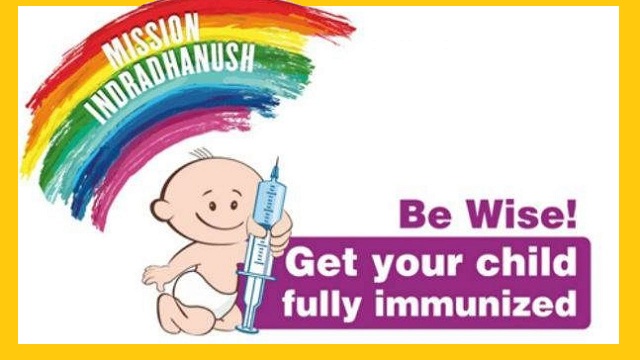To re-energize and strengthen the programme to attain full immunization coverage for all pregnant women and kids at a rapid pace, the Gov of India introduced Mission Idradhanush in Dec 2014.
The mission was introduced in to offer accessible and affordable healthcare to all citizens of the nation.
Its focus to immunise all kids under the 2 years of age hierarchy along with all pregnant women, against eight vaccine-preventable diseases
These diseases are Hepatitis B, whooping cough, meningitis, measles, tuberculosis, poliomyelitis, tetanus and diptheria.
Intensified Mission Indradhanush (IMI) 3.0 with a target on pregnant women and kids who miss out their vaccine doses during the coronavirus pandemic.
The Mission Indradhanush goal is to cover up all those kids who are partially vaccinated or either unvaccinated against vaccine preventable ailment. UIP program offer free vaccines against 12 life threatening diseases, to 26 million kids annually. The Universal Immunization Programme offer life-saving vaccines to all kids across the India free of cost to protect them against various diseases.
Focus of the IMI 3.0 will be the pregnant women and kids who have miss out their vaccine doses during the Coronavirus pandemic. They will be vaccinated during the two phase rounds of IMI 3.0. Each level will be for 15 days each. Beneficiaries from migration zones and tough to reach zones will be focused as they may have miss out their vaccine doses during coronavirus.
The current eighth campaign will aim to attain 90% Full Immunization Coverage (FIC) in all districts of the India and help the coverage through immunization method foster and strengthening nations march towards the Sustainable Development Goals.
Contents
Background
- Mission cover up 690 districts and protected/vaccinated 9.46 million pregnant women and 37.64 million kids.
- Mission Indradhanush was introduced in 2014 vision of the Hon. Prime Minister Shri Narendra Modi ji to offer accessible and affordable healthcare to all citizens of the nation.
- The districts have been classified to reflect 250 as high risk, 313 low risk; 152 as medium risk districts.
- Every year the Universal Immunization pattern serve to the vaccination requirements of 2.9 crore pregnant women and 2.65 crore children against 12 Vaccine Preventable Diseases.
Requirement for Intensified Mission Indradhanush (IMI)
- The Intensified Mission Indradhanush 0 will construct on the gains of previous phases of the campaign and make out lasting benefits towards UI.
- The gov. of India is indeed a victorious structure to reach out to every dropped out and left out pregnant woman and child.
- The execution of huger campaigns like Intensified Mission Indradhanush (IMI) 3.0 is a transparent indication of India’s health system getting stronger day by day.
- Its focus to reach the unreached population with all the accessible vaccines under Universal Immunisation Programme (UIP).
Crucial Objectives of Intensified Mission Indradhanush 3.0
- The mission will have two level rounds initiate from Feb 22 and March 22, 2021.
- It will be managed inpre-identified 250 urban areas/districts across 29 UTs/ States in the nation.
- The focus of the IMI 3.0 will be the pregnant women and children who have missed their vaccine doses during the Coronavirus pandemic.
- The current eighth campaign will focused attaining 90% Full Immunization Coverage (FIC)in all districts of India.
- It would support the coverage through immunization process foster and strengthening India’s march towards the Sustainable Development Goals.
Areas Under Focus
The following zones are targeted through special immunization campaigns:
- High risk zones identified by the polio eradication programme. These include populations living in zones such as:
- Urban slums with migration
- Nomads
- Brick kilns
- Construction sites
- Other migrants (fisherman villages, riverine zones with shifting populations etc.) and
- Valueless and tough to reach populations (tribal and forested populations etc.)
- Zones with lesser RI coverage (pockets with Measles/vaccine preventable disease (VPD) outbreaks).
- Zones with vacant sub-centers: No ANM posted for more than three months.
- Zones with overlook Routine Immunisation (RI) sessions: ANMs on long leave and similar reasons
- Hamlets, Small villages, purbas or dhanis clubbed with another village for RI sessions and not having independent RI sessions.
Development of Immunisation Programme in India
- Ministry of Health and Family Welfare launched the Immunization Programme in the country in 1978. It was issued in the name of
- In 1985, the Expanded Programme of Immunization programme was modified as ‘Universal Immunization Programme’ (UIP). This was to be executed in a phased manner to support all districts in the nation. Despite being functional for many years, UIP able to fully immunize only 65% of kids in their first year of life.
Mission Indradhanush
- It was introduced in 2014. The goal of the mission was to certain full immunization with all accessible vaccines for kids up to two years of age. Further, the mission goal to vaccinate pregnant women who were either partially vaccinated or unvaccinated under UIP.
- Diseases covered for Vaccines: Under this purpose, vaccination is offered free of cost against 12 vaccine-preventable diseases. Such as Rubella, Measles, Hepatitis B, Rotavirus diarrhoea, Pertussis, Diphtheria, severe form of Childhood Tuberculosis, Polio, Tetanus, Meningitis and Pneumonia caused by Haemophilus Influenzae type B, Japanese Encephalitis and Pneumococcal Pneumonia.
- However, under Mission Indradhanush,Vaccination against Haemophilus influenza type B and Japanese Encephalitis is offered only in selected districts of the nation.
Intensified Mission Indradhanush(IMI)
- It was introduced in 2017. The goal was to vaccinate each and every kid up to two years of age. Apart from that, Intensified Mission Indradhanush also vaccinates all those pregnant women who have been left uncovered under the routine immunisation programme.
- Special focus was provided to less coverage and unserved pockets and urban slums with a migratory population.
- Special vaccination drives were conducted under IMI. These drives focused to certain complete immunization coverage in 90% of selected cities and districts by 2018.
Intensified Mission Indradhanush (IMI) 2.0
- It was introduced in December 2019. It aimed to attain targets of full immunization coverage in 272 districts of 27 States. Full immunization of 652 blocks in Bihar and Uttar Pradesh also focused. Hard-to-reach and wide tribal populated region were selected as blocks
- The mission has a focus on urban, under served population and tribal areas.
- IMI 2.0 also had Inter-ministerial and inter-departmental coordination.
Intensified Mission Indradhanush (IMI) 3.0
- It aims to cover pregnant women and kids who miss up the routine immunization during the coronavirus pandemic.
- Beneficiaries from migration zones and tough to reach areas will be focused.
- The mission will follow uo the COVID-Appropriate Behavior(CAB) pattern during the immunization activities.
- States have been told to follow up a staggered approach (Staged approach) to ignore cram at the vaccination sites.
- The vaccination sessions will be plan out in such a manner that not more than 10 beneficiaries will be available at the session site at one given point in time.




